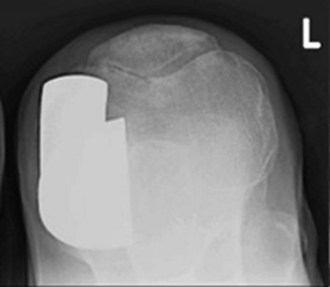CHAPTER 16 The Patella in Medial Unicompartmental Knee Arthroplasty
 The premise behind Oxford criteria is that UKA is utilized to treat anteromedial osteoarthritis. When these criteria are present, other unnecessary contraindications such as age, weight, and the status of the patellofemoral articulation can be safely ignored without affecting the outcome of Oxford UKA.
The premise behind Oxford criteria is that UKA is utilized to treat anteromedial osteoarthritis. When these criteria are present, other unnecessary contraindications such as age, weight, and the status of the patellofemoral articulation can be safely ignored without affecting the outcome of Oxford UKA. Correction of varus deformity with preservation of the anterior cruciate ligament has a protective effect on the patellofemoral joint, even if there is significant arthritic disease present.
Correction of varus deformity with preservation of the anterior cruciate ligament has a protective effect on the patellofemoral joint, even if there is significant arthritic disease present. Cementing technique is critical to prevent loosening, and the removal of impinging osteophytes is paramount to reduce the potential for dislocation and increased wear.
Cementing technique is critical to prevent loosening, and the removal of impinging osteophytes is paramount to reduce the potential for dislocation and increased wear. Medial UKA is a conservative procedure that can accurately correct malalignment, and restore an arthritic knee to its predisease functional status with normal kinematics and tremendous pain relief.
Medial UKA is a conservative procedure that can accurately correct malalignment, and restore an arthritic knee to its predisease functional status with normal kinematics and tremendous pain relief.Introduction
Unicompartmental knee arthroplasty (UKA) or partial knee replacement represents the ultimate minimally invasive procedure for treating degenerative joint disease of the knee in the appropriately indicated patient. The conservative nature of the procedure stems from the bone conservation, the preservation and correction of normal ligamentous structures, and the restoration of normal knee kinematics. These outcomes cannot be achieved with any total knee arthroplasty (TKA). By incorporating a fully congruent, meniscal bearing, the Oxford UKA (Biomet, Inc., Warsaw, IN) has demonstrated some of the lowest wear rates seen with any knee implant in both retrieval studies and RSA studies, averaging 0.02 mm per year in both.1,2 Thus, wear does not appear to be a limiting factor in the indications for or contraindications against UKA using this device. The fully congruent articulation provides a larger contact area and reduces the contact stresses, leading to significantly decreased wear when compared to fixed bearing, noncongruent designs. Other design-specific differences, such as an inset, spherical femoral component, may specifically address the patellofemoral joint problems seen with many fixed-bearing UKA designs. The long-term outcomes that have been published using this device make it one of the most successful devices available today for the treatment of medial compartmental disease of the knee and therefore make this device the logical choice for UKA. Survivorship rates out to 15 years and 20 years have been 95% and 92%, respectively, in an independent series.3
The indications for UKA have been debated widely over the past several decades. Classical indications, when followed closely, have included only a very small percentage of degenerative knees. The Kozinn and Scott criteria limit the utilization of UKA to those patients older than 60 years, weighing less than 82 kg, and exclude active individuals. Additionally, these classical indications exclude cumulative deformity of more than 15°, any fixed flexion contracture of more than 5°, and more than minimal arthritic changes in the patellofemoral joint.4 With these indications, only between 2% and 12% of arthritic knees would meet the criteria for UKA.5,6 The so-called Oxford criteria are somewhat more liberal and encompass an anatomic and radiographic philosophy for inclusion or exclusion of patients. The premise behind these expanded criteria is that UKA is utilized to treat a specific disease entity: anteromedial osteoarthritis. Anteromedial disease is defined as the combination of full-thickness cartilage loss in the medial compartment, a correctible intra-articular varus deformity, and preserved lateral joint space seen with a valgus stress radiograph. By definition, these criteria are only present when the ligaments are functionally intact and the disease is confined to the anterior one third or two thirds of the tibial plateau. When these criteria are present, other unnecessary contraindications such as age, weight, and the status of the patellofemoral articulation can be safely ignored without affecting the outcome of Oxford UKA.
In the United States, perhaps the biggest area of debate is the status of the patellofemoral joint. Concern over the status of this joint in an otherwise suitable candidate for UKA is also unwarranted. It is this author’s opinion that the correction of varus deformity with preservation of the anterior cruciate ligament has a protective effect on the patellofemoral joint, even if there is significant arthritic disease present. Despite ignoring patellofemoral disease, the long-term results of Oxford UKA have not been affected by progression of patellofemoral disease or anterior knee pain (Fig. 16–1).
< div class='tao-gold-member'>
Stay updated, free articles. Join our Telegram channel

Full access? Get Clinical Tree









